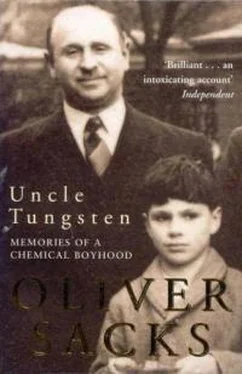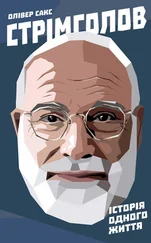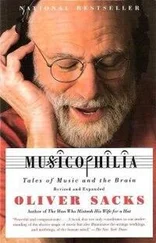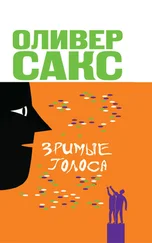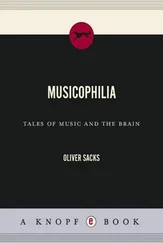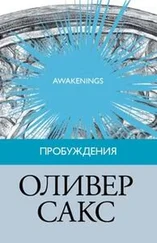Davy himself pioneered the use of electrochemical displacement for protecting the copper bottoms of ships from corrosion in seawater, attaching to them plates of more electropositive metals (such as iron or zinc), so that these would become corroded instead, a so-called cathodic protection. (Though this seemed to work well under laboratory conditions, it did not work well at sea, because the new metal plates attracted barnacles – and thus Davy’s suggestion was ridiculed. Yet the principle of cathodic protection was brilliant, and eventually became, after his death, a standard way of protecting the bottoms of ocean-going vessels.)
Reading about Davy and his experiments stimulated me to a variety of other electrochemical experiments: I put an iron nail in water, attaching a piece of zinc to it to protect it from corrosion. I removed the tarnish from my mother’s silver spoons by putting them in an aluminium dish with a warm solution of sodium bicarbonate. She was so pleased by this that I decided to go further and try electroplating, using chromium as the anode and a variety of household objects as the cathode. I chromium-plated everything I could lay hands on – iron nails, bits of copper, scissors, and (this time to my mother’s considerable annoyance) one of the silver spoons that I had previously cleaned of tarnish.
* * *
I did not realize at first that there was any connection between these experiments and the batteries I was playing with at the same time, although I thought it an odd coincidence that the first pair of metals I used, zinc and copper, could produce either a tree or, in a battery, an electric current. I think it was only when I read that, to get a higher voltage, batteries used nobler metals such as silver and platinum that I started to realize that the two series – the ‘tree’ series and Volta’s series – were probably the same, that chemical activity and electrical potential were in some sense the same phenomenon.
We had a large old-fashioned battery, a wet cell, in the kitchen, hooked up to an electric bell. The bell was too complicated to understand at first, and the battery, to my mind, was more immediately attractive, for it contained an earthenware tube with a massive, gleaming copper cylinder in the middle, immersed in a bluish liquid; all this inside an outer glass casing, also filled with fluid, and containing a slimmer bar of zinc. It looked like a miniature chemical factory of sorts, and I thought I saw little bubbles of gas, at times, coming off the zinc. This Daniell cell (as it was called) had a thoroughly nineteenth-century, Victorian look about it, and this extraordinary object was making electricity all by itself – not by rubbing or friction, but just by virtue of its own chemical reactions. That this was quite another source of electricity, not frictional or static, but a radically different sort of electricity, must have seemed astounding in the extreme, a new force of nature, when Volta discovered it in 1800. Previously there had been only the fugitive discharges, the sparks and flashes, of frictional electricity; now one could have at one’s disposal a steady, uniform, unvarying current. One only needed two different metals – copper and zinc would do, or copper and silver (Volta worked out a whole series of metals, differing in the ‘voltage’, the potential difference, between them), immersed in a conducting medium.
The first batteries I made myself used fruit or vegetables – one could stick copper and zinc electrodes into a potato or a lemon and get enough current to light a tiny 1-volt bulb. And one could wire half a dozen lemons or potatoes together (in series to get a higher voltage, or in parallel to get more power) to make a biological ‘battery.’ After the fruit and vegetable batteries, I turned to coins, using alternating copper and silver coins (one had to use silver coins made before 1920, for later ones were debased) with moistened (usually saliva-moistened) blotting paper between them. If I used small coins, farthings and sixpences, I could get five or six such couples in an inch, or I could make a pile a foot high, with sixty or seventy couples, enclosed in a tube, which could give quite a sharp, 100-volt shock. One could go on, I thought, to make an electric stick filled with narrow couples of copper and zinc foil, a lot thinner than coins. Such a stick, with five hundred or more couples, might generate a thousand volts, more even than an electric eel, enough to frighten off any assailant – but I never got as far as making one.
I was fascinated by the huge range of batteries developed in the nineteenth century, some of which I could see in the Science Museum. There were ‘single fluid’ batteries, like Volta’s original cell, or the Smee, or the Grenet, or the massive Leclanche, or the slim, silver battery of de la Rue; and there were two-fluid batteries, like our own Daniell, and the Bunsen, and the Grove (which used platinum electrodes). Their number seemed endless, but all were designed, in their different ways, to secure a more reliable and constant flow of current, to protect the electrodes from the deposition of metal or the adherence of gas bubbles, and to avoid (as some batteries caused) the emission of noxious or inflammable gases.
These wet cells had to be topped up with water from time to time; but the little dry cells in our torches were clearly different. Marcus, seeing my interest, dissected one for me, using his powerful scout knife, showing me the outer case of zinc, the central carbon rod, and the rather corrosive and strange-smelling conducting paste between them. He showed me the massive 120-volt battery in our portable radio (this was a necessity in the war, when the electricity supply was so erratic) – it contained eighty linked dry cells, and weighed several pounds. And once he opened the bonnet of the car – we had the old Wolseley at the time – and showed me the accumulator, with its lead plates and acid, and explained how this had to be charged, and could carry a charge repeatedly, but not generate one itself. I adored batteries, and they did not have to be live; when my interest was made known to the family, used batteries of all shapes and sizes poured in, and I rapidly accumulated a remarkable (though wholly useless) collection of the things, many of which I opened and dissected.
But my favorite remained the old Daniell cell, and when we went modern and got a natty new dry cell for the bell, I appropriated the Daniell for myself. It had only a modest voltage of 1 or 1½ volts, but the current, several amperes, was considerable in view of its size. This made it very suitable for heating and lighting experiments, where one needed a substantial current, but the voltage hardly mattered.
Thus I could readily heat wire – Uncle Dave had supplied me with a whole bandolier of fine tungsten wire of all different thicknesses. The thickest wire, two millimeters in diameter, became mildly warm when I connected a length of it across the terminals of the cell; the thinnest wire grew white-hot and incinerated in a flash; there was a comfortable in-between wire that one could maintain for a little while at red heat, though even at this temperature it soon oxidized and disintegrated into a fluff of yellowish white oxide. (Now I knew why it had been crucial to remove the air from lightbulbs, and why incandescent lighting was not possible unless the bulbs were evacuated or filled with an inert gas.)
I could also, using the Daniell as a source of power, decompose water if it was briny or acidulated. I remember the extraordinary pleasure I got from decomposing a little water in an eggcup, seeing it visibly separate into its elements, oxygen at one electrode, hydrogen at the other. The electricity from a 1-volt cell seemed so mild, and yet it could suffice to tear a chemical compound apart, to decompose water or, more dramatically, salt into its violently active constituents.
Читать дальше
